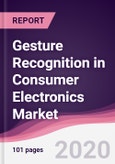What is Gesture Recognition?
Gesture Recognition refers to a technology that identifies human gesture to communicate and control the electronic devices. Gesture refers to movements of fingers, hands, body and other physiological controls. This technology uses different sensors like infrared sensors, image sensors among others to recognize and interact with the devices. This increases stability and accuracy for real time applications as it doesn’t need any physical input or mechanical devices to communicate with the devices. Gesture recognition caters its application primarily in man-machine interaction, creation of 3D animation, gaming devices, control of mechanical systems, visualization and many more.
What are the major applications of Gesture Recognition ?
The major application of Gesture Recognition in consumer electronics include smart phones, tablets, laptops, PCs, televisions, set top boxes, and others. Gesture recognition in smart television enables the viewers to control their smart TVs with finger and hand gestures. Smart TVs recognition engine tries to match user’s hand gestures to predefined set of gestures. This operation can be performed locally by the TV. The gesture recognition software can either directly be integrated on smart TV platform or it can be used on an accessory camera.
Gesture recognition for PCs and desktops has been one of the trending aspects in the modern world of gadgetry. Human gesture recognition is one of the newest ways to input information or control a computer. This gesture recognition technology enables the user to naturally and intuitively interact with the computer making the PC viewing and usage experience more interactive and realistic.
Gesture Recognition in Consumer Electronics Market
Market Research and Market Trends of Gesture Recognition
A new technology has been launched for easy deployment of motion based user interfaces for future connected home systems which offer an intuitive and smart way to control interactive content through hand and finger gestures.
Logbar designed a smart wearable input device ring which enables the user to perform many tasks that include gesture control of smart appliances and devices synced to it, send texts, pay bills etc. with the help of finger movements.
Research is being done to develop a chip that could be used for gesture recognition on headsets and smart watches using ultrasound gesture recognizer technology, unlike the devices that use light to recognize hand gestures.
Who are the Major Players in Gesture Recognition Market ?
The companies referred in the market research report include Microsoft Corporation (U.S.), Samsung Electronics (South Korea), Intel Corporation (U.S.), Sony Corporation (Japan), Texas Instruments (U.S.), Soft Kinetic (Belgium) more than 10 other companies.
What is our report scope?
The report incorporates in-depth assessment of the competitive landscape, product market sizing, product benchmarking, market trends, product developments, financial analysis, strategic analysis and so on to gauge the impact forces and potential opportunities of the market. Apart from this the report also includes a study of major developments in the market such as product launches, agreements, acquisitions, collaborations, mergers and so on to comprehend the prevailing market dynamics at present and its impact during the forecast period 2018-2023.
Key Takeaways from this Report
- Evaluate market potential through analyzing growth rates (CAGR %), Volume (Units) and Value ($M) data given at country level – for product types, end use applications and by different industry verticals.
- Understand the different dynamics influencing the market – key driving factors, challenges and hidden opportunities.
- Get in-depth insights on your competitor performance – market shares, strategies, financial benchmarking, product benchmarking, SWOT and more.
- Analyze the sales and distribution channels across key geographies to improve top-line revenues.
- Understand the industry supply chain with a deep-dive on the value augmentation at each step, in order to optimize value and bring efficiencies in your processes.
- Get a quick outlook on the market entropy – M&A’s, deals, partnerships, product launches of all key players for the past 4 years.
- Evaluate the supply-demand gaps, import-export statistics and regulatory landscape for more than top 20 countries globally for the market.
Table of Contents
Methodology

LOADING...








